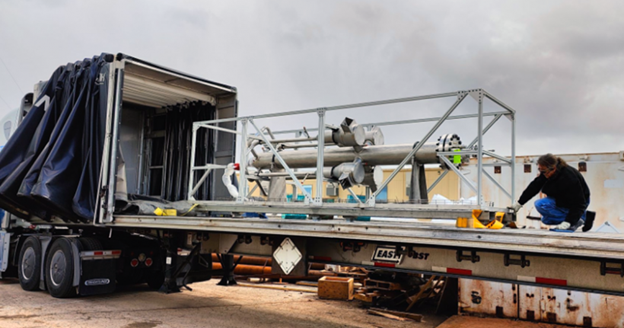
INL prepares to ship PCAT by truck to Pennsylvania for testing. (Photo: INL)
An electric-powered prototype of MARVEL, the tiny microreactor designed and planned for operation inside the Transient Reactor Test (TREAT) facility at Idaho National Laboratory, has successfully been installed at a manufacturing facility in Pennsylvania ahead of a testing program that could begin as early as July, the Department of Energy announced on May 22.
Measuring 12 feet tall and weighing 2,000 pounds, the nonnuclear primary coolant apparatus test (PCAT) is a full-scale replica of the DOE’s MARVEL microreactor. PCAT was assembled at INL over a nine-month period that ended in January 2022.
Pennsylvania testing: PCAT was recently transported by truck from INL to a manufacturing facility owned by Creative Engineers Inc. (CEI) in New Freedom, Pa. CEI installed PCAT inside a two-story frame, where it will be loaded with sodium-potassium and lead-bismuth coolants.
During testing, PCAT will be electrically powered while data is collected on system temperatures and coolant flow. According to the DOE, the information will ensure the accuracy of MARVEL’s modeling and simulation tools.
“Validation of our physics models is critical to nuclear quality assurance for any new reactor development project,” said Yasir Arafat, the chief designer and project lead of MARVEL. “PCAT will generate this first-of-a kind-data for validating our thermal-hydraulics simulation tools and quantifying uncertainty for liquid metal thermal reactors, like MARVEL.”
About MARVEL: MARVEL will be a sodium-potassium–cooled, HALEU-fueled microreactor generating just 100 kilowatts of power. Its developers expect the microreactor technology to begin operation at INL by the end of 2024 and become the first new test reactor at the lab in more than four decades. (Project Pele, the Department of Defense’s mobile microreactor demonstration, is also in the running for that distinction; BWXT was awarded a contract to build and deliver Project Pele in June 2022.)
MARVEL is expected to help reactor developers validate specific reactor components for remote monitoring and autonomous control using sensors and instrumentation for live data collection. MARVEL will be connected to INL’s first nuclear microgrid, where it will demonstrate the reactor’s response to changing grid demand through integration with renewable energy systems, water purification, and hydrogen production.
In progress: MARVEL received its final environmental assessment in the summer of 2021. The fabrication of long-lead components for MARVEL, such as Stirling engines, is underway.
According to the DOE, PCAT “will likely remain at CEI until the operation of MARVEL begins to provide further simulation and testing. Once the MARVEL microreactor is active, PCAT may be returned to INL to be used for additional research to help advance microreactor technologies.”